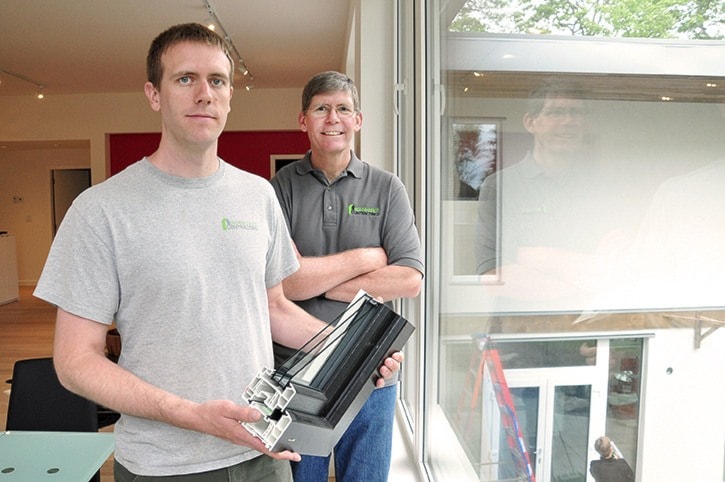Mark Bernhardt had high expectations of his new home.
He expected Vancouver Island’s first “passive house,” a home he built with his father Rob Bernhardt at Bernhardt Contracting to be 60 to 90 per cent more efficient than standard house construction to perform well. He wasn’t expecting the level of comfort he experienced upon moving in last May. And though he knew his energy bill would be low, he wasn’t expecting it to come in at about $200 for an entire year.
When the air-tight, 3,800-square-foot Saanich home with six residents can require such little use of its hot water radiator, it means even body heat is a vital source warmth. That 60 watts per person makes a difference, Bernhardt says.
“My two kids probably run a little hotter than everybody else,” he adds with a laugh.
As gratifying as all the energy efficiency savings have been, it’s the environment inside the home that has the builder most enthused.
“There’s no cold spots, no drafts; the noise from outside has been really reduced. A house like this on a busy street would be really quite amazing to live in. You just wouldn’t hear the traffic. With the fresh air, we know that allergy symptoms are reduced.”
This spring the Bernhardts applied to the City of Victoria to build a six-condo passive home unit on Queen Street. The North Park Passive House, designed by Hughes Condon Marler Architects, has the same estimated construction costs as a standardly-built project of the same size. Whether the units are rented or sold, Berhardt says they’ll come with a reasonable price tag.
“It will have all the comfort features of a passive house, but with the style of housing that we think is more valuable to the city right now. It doesn’t need to have the bling-y things that you see in some of the penthouses in some of the new condos around.”
Ultra energy-efficient homes are a trend for those educated enough to know what’s happening in other countries, where energy is more expensive and less green, says Peter Johannknecht, principal architect with Cascadia Architects. Johannknecht specializes in energy efficient design and worked on the Berhardts’ home in Saanich with Cascadia co-founder Greg Damant.
“As a trend, Victoria and B.C. in general have a very strong community of green builders and designers and architects sharing and making these homes ready for the next 50 to 100 years,” Johannknecht says.
Currently, experiences are shared within this community via channels such as the Canadian Passive House Institute, located in Vancouver, and their social media sites. While most of the interest in passive homes in Canada is here in B.C., the idea is spreading throughout North America.
“What’s really missing or lacking is some provincial or federal support to help this trend develop quicker and faster, so that the benefits on the climate and the new homes would be faster,” Johannknecht says. “Europe is way ahead of us with the governments, local and provincial and especially federal governments sets their demands very high and the industry has to follow. And it does. Suddenly the high standard becomes the norm. That’s exactly what needs to happen here.”
While we may be lagging in terms of standards, buyers of all kinds have long since concerned themselves with efficiency costs. “What’s the heating bill like?” is a question Victoria Real Estate Board president Tim Ayres has heard for years. Now, buyers are able to view a home’s EnerGuide rating, if the seller has sought one, on the MLS home listing service.
“Buyers have already started to consider energy-efficient homes over older homes. If you’ve don’t the energy-efficient upgrades, you’re going to have a much easier time selling and you’re probably going to sell for a bit more than you would if you hadn’t done it. It’s becoming more and more important going forward,” says Ayres. “Any amount that you do spend extra tends to recoup itself in a short amount of time.”
energy efficiency at home
Natural Resources Canada provides more information on the following resources at nrcan.gc.ca/energy/efficiency/housing.
EnerGuide ratings – An EnerGuide rating shows a standard measure of your home’s energy performance. It shows you (and future buyers) exactly how energy efficient your home is.
R-2000 homes – Best-in-class energy-efficient homes, R-2000-certified homes include high levels of insulation, clean air features and measures to help protect the environment, built to the R-2000 Standard developed by Natural Resources Canada (NRCan).
ENERGY STAR homes – An ENERGY STAR® qualified new home is on average 20 percent more energy efficient than a home built to code, a practical choice for homeowners looking for a new home that is energy efficient and environmentally friendly.
nnorth@saanichnews.com
